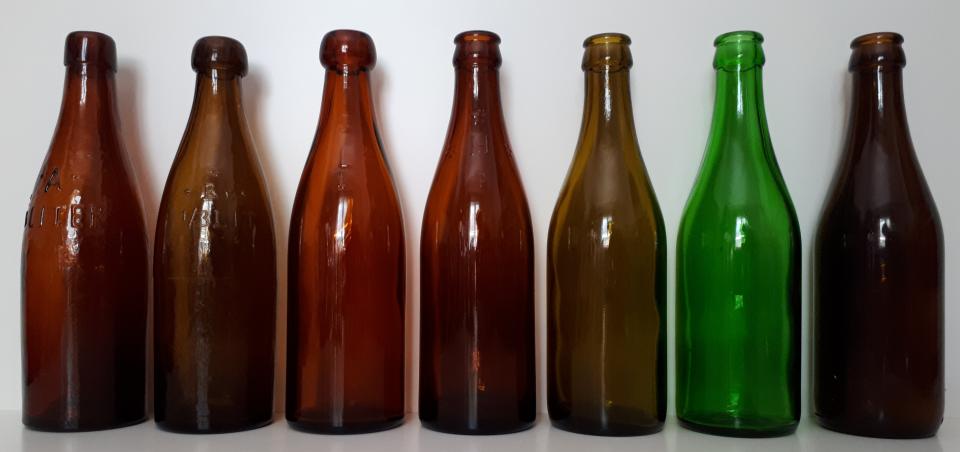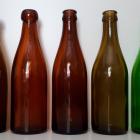In today’s global sustainability discourse, a focus centers on mitigating the use of single-use materials. However, delving into Sweden’s historical landscape unveils a reversed narrative—a tale where formal institutions and market forces institutionalized disposables during the previous century. The transition from refillable glass bottles was global. In Sweden, however, the story stemmed from the world’s first standardized bottle, the “Stockholm bottle.”
With the introduction of lager beer in Sweden during the nineteenth century, barrels needed to be continuously emptied. However, hand-blown glass bottles were so expensive that consumers could only obtain them on loan in exchange for a deposit fee. To streamline the return system, the Swedish Brewers Association standardized the bottles in 1886, marking the advent of the Stockholm bottle (figure 1). After returning the bottles, they underwent inspection, cleaning, and refilling. Regardless of beverages, whether it be soda or beer, the breweries had to use the standardized bottles, albeit with individual labels.

Few changes have been imposed to the 33-centiliter Stockholm bottle, intended for one hundred refills, since its introduction in 1886. During the 1930s, machine blowing was introduced, and the cork was replaced with a cap. The bottle can still be purchased in Sweden at a few places, mainly cafes.
Few changes have been imposed to the 33-centiliter Stockholm bottle, intended for one hundred refills, since its introduction in 1886. During the 1930s, machine blowing was introduced, and the cork was replaced with a cap. The bottle can still be purchased in Sweden at a few places, mainly cafes.
© 2019 Per Henriksson
 This work is licensed under a Creative Commons Attribution-NoDerivatives 4.0 International License.
This work is licensed under a Creative Commons Attribution-NoDerivatives 4.0 International License.
The production of beer, just like other goods, increased in Sweden after the Second World War. But the negative effects of increased alcohol consumption became particularly evident. However, the brewing industry skillfully navigated the debate by redirecting the focus away from the negative social consequences of alcohol to blaming the clumsy design of the Stockholm bottle for the deteriorating reputation of alcohol. Hence, to improve beer’s image, new packaging was introduced. In 1955, when the Swedish rationing system was abolished, consumers were offered beer in steel cans, and shortly thereafter, the first disposable, nonstandardized glass bottle was released.
However, the transition to single-use materials was not simple. The US historian Susan Strasser portrays in her book Waste and Want how the market was forced to change a culture characterized by frugality in the mid-twentieth century to be able to sell disposable items. Discarding was considered wasteful and shameful. Therefore, the brewing industry began strategically promoting the convenience of disposable materials in relation to the growing interest in leisure.
An illustrative example is found in an advertisement for the new beer “Pripps” featured in a sailing magazine from 1961 (figure 2). The advertisement emphasized the advantage of not having to take the empty can home; it could easily disappear into the sea through “a hole in the bottom.” Furthermore, one of Sweden’s largest grocery retailers, ICA, listed the benefits of disposable materials for housewives in their own magazine, as they were relieved of the burdensome tasks of “carry[ing] empty bottles to the store,” dealing with “bags … getting messy,” and navigating the “hassle of deposits.”
As the sales of single-use packaging increased, its negative effects became increasingly apparent. People’s protests against the growing littering problem prompted discussions in the Swedish parliament to restrict single-use packaging. However, the industry had realized the marketing value of personalized packaging. An illustrative episode unfolded in a letter from Coca-Cola’s headquarters to the Swedish prime minister, emphasizing the important role of their bottle’s distinctive curvy shape. Therefore, they could not accept the standardized bottles and threatened to halt sales. So rather than banning single-use production, the political measures focused on mitigating the symptoms, to appease the market.

Advertisement for the beer Pripps from 1961, emphasizing the convenience of disposable materials.
Advertisement for the beer Pripps from 1961, emphasizing the convenience of disposable materials.
© Göteborgs Kungliga Segelsällskap
Used by permission
The copyright holder reserves, or holds for their own use, all the rights provided by copyright law, such as distribution, performance, and creation of derivative works.
Littering was prohibited, and fines were imposed for minor littering. Municipalities placed trash bins around communities and parks, an essential infrastructure for disposability. The industry in collaboration with the government initiated extensive antilittering campaigns such as “Keep Sweden Clean.” The environmental historian Finis Dunaway argues in his book Seeing Green that these campaigns, prevalent in the Global North, operated to instill a sense of individual guilt and thereby motivate people to clean up nature, just as in their homes.
To create an incentive to return single-use packaging, deposit refund systems were also introduced for disposable materials. By political decisions such as implementing laws, infrastructure, campaigns, and deposits to regulate littering, social acceptance was fostered, and single-use materials became institutionalized.
Between the 1960s and the 1980s, the refillable bottles coexisted with disposables in Sweden. However, when Sweden became a member of the European single market in 1995, the state lost its import monopoly on alcohol, along with the exclusivity to tap imported beverages in standardized refillable bottles. Moreover, trays with the standardized 33-centiliter Stockholm bottles had become a catchpenny at the retail stores, resulting in small margins throughout the value chain. The introduction of disposable materials created opportunities to increase profits. By filling drinks into new containers, such as 50-centiliter plastic bottles, and placing them in store refrigerators, retailers could charge a significantly higher price per liter. Shortly after the transition to PET bottles, soda prices increased by 100 percent per liter.
Additionally, the introduction of disposable materials relieved the industry of the responsibility for waste, saving time, cost, and space. Breweries externalized these costs to the state and tax payers, according to the US business historian Bart Elmore, by adopting disposable packaging. Today, almost 140 years after their introduction, there are still a few places in Sweden that sell the Stockholm bottles, which indicates that there were breweries and retailers that resisted the phaseout. However, the consumer knowledge that they are refillable has been lost, and most are discarded as single-use glass. This comes as no surprise since today’s deposit return system no longer accepts the refillable Stockholm bottle. Hence, reversing the trend, to yet again introduce reusable packaging will not be easy, because it requires businesses to engage in something they now consider beyond their core activities and costs.
How to cite
Johansson, Nils. “The Becoming of Single Use: The Institutionalization of Disposables during the Twentieth Century in Sweden.” Environment & Society Portal, Arcadia (Spring 2024), no. 6. Rachel Carson Center for Environment and Society. doi:10.5282/rcc/9699.
ISSN 2199-3408
Environment & Society Portal, Arcadia
2024 Nils Johansson
This refers only to the text and does not include any image rights.
Please click on an image to view its individual rights status.
- Dunaway, Finis. Seeing Green: The Use and Abuse of American Environmental Images. Chicago: University of Chicago Press, 2015. doi:9780226169934.001.0001.
- Elmore, Bartow. “The American Beverage Industry and the Development of Curbside Recycling Programs, 1950–2000.” Business History Review 86, no. 3 (2012): 477–501. doi:10.1017/S0007680512000785.
- Friedel, Robert. “American Bottles: The Road to No Return.” Environmental History 19, no. 3 (2014): 505–27. doi:10.1093/envhis/emu061.
- Jørgensen, Finn Arne. Making a Green Machine: The Infrastructure of Beverage Container Recycling. New Brunswick, NJ: Rutgers University Press, 2011. doi:10.2307/j.ctt5hjgjz.
- Strasser, Susan. Waste and Want: A Social History of Trash. New York: Macmillan, 2000.








